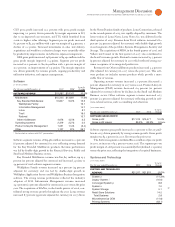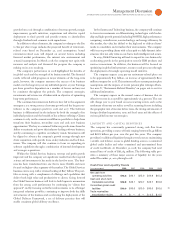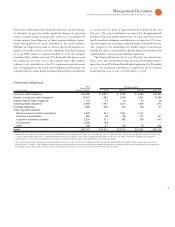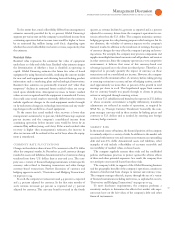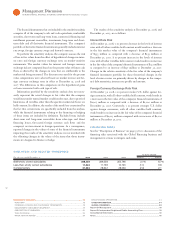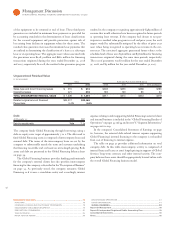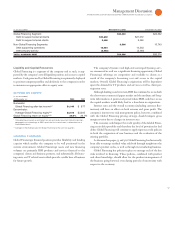IBM 2008 Annual Report Download - page 53
Download and view the complete annual report
Please find page 53 of the 2008 IBM annual report below. You can navigate through the pages in the report by either clicking on the pages listed below, or by using the keyword search tool below to find specific information within the annual report.
Management Discussion
INTERNATIONAL BUSINESS MACHINES CORPORATION and Subsidiary Companies
To the extent that actual collectibility differs from management’s
estimates currently provided for by percent, Global Financing’s
segment pre-tax income and the company’s consolidated income from
continuing operations before income taxes would be higher or lower
by an estimated $ million (using data), depending upon
whether the actual collectibility was better or worse, respectively, than
the estimates.
Residual Value
Residual value represents the estimated fair value of equipment
under lease as of the end of the lease. Residual value estimates impact
the determination of whether a lease is classified as operating or
capital. Global Financing estimates the future fair value of leased
equipment by using historical models, analyzing the current market
for new and used equipment and obtaining forward-looking product
information such as marketing plans and technological innovations.
Residual value estimates are periodically reviewed and “other than
temporary” declines in estimated future residual values are recog-
nized upon identification. Anticipated increases in future residual
values are not recognized until the equipment is remarketed. Factors
that could cause actual results to materially differ from the estimates
include significant changes in the used-equipment market brought
on by unforeseen changes in technology innovations and any result-
ing changes in the useful lives of used equipment.
To the extent that actual residual value recovery is lower than
management’s estimates by percent, Global Financing’s segment
pre-tax income and the company’s consolidated income from
continuing operations before income taxes would be lower by an
estimated $ million (using data). If the actual residual value
recovery is higher than management’s estimates, the increase in
after-tax income will be realized at the end of lease when the equip-
ment is remarketed.
Changes in the relative values of non-U.S. currencies to the U.S. dollar
affect the company’s results. At December , , currency changes
resulted in assets and liabilities denominated in local currencies being
translated into fewer U.S. dollars than at year-end . The com-
pany uses a variety of financial hedging instruments to limit specific
currency risks related to financing transactions and other foreign
currency-based transactions. Further discussion of currency and
hedging appears in note L, “Derivatives and Hedging Trans actions,”
on pages to .
In , the company’s revenue increased . percent as reported
and . percent adjusted for currency. In the first nine months of
, revenue increased . percent as reported and . percent
adjusted for currency. This currency benefit reversed in the fourth
quarter, as revenue declined . percent as reported and . percent
adjusted for currency, driven from the company’s operations in cur-
rencies other than the U.S. dollar. The company maintains currency
hedging programs for cash planning purposes which mitigate, but do
not eliminate, the volatility of currency impacts on the company’s
financial results. In addition to the translation of earnings, the impact
of currency changes also may affect the company’s pricing and sourc-
ing actions. For example, the company may procure components and
supplies in multiple functional currencies and sell products and services
in other currencies. Since the company operates in a very competitive
environment, it believes that some of this currency-based cost
advantage is passed on to the client in reduced price. Therefore, it is
impractical to precisely quantify the impact of currency on these
transactions and on consolidated net income. However, the company
estimates that the maximum effect of currency, before taking pricing
or sourcing actions into account, and net of hedging activity, contrib-
uted approximately no more than percent of the growth in total
earnings per share in . This hypothetical upper limit assumes
that no currency benefit was passed through to clients in pricing
actions or mitigated through sourcing actions.
For non-U.S. subsidiaries and branches that operate in U.S. dollars
or whose economic environment is highly inflationary, translation
adjustments are reflected in results of operations, as required by
SFAS No. , “Foreign Currency Translation.” Generally, the com-
pany manages currency risk in these entities by linking prices and
contracts to U.S. dollars and, as needed, by entering into foreign
currency hedge contracts.
In the normal course of business, the financial position of the company
is routinely subject to a variety of risks. In addition to the market risk
associated with interest rate and currency movements on outstanding
debt and non-U.S. dollar denominated assets and liabilities, other
examples of risk include collectibility of accounts receivable and
recoverability of residual values on leased assets.
The company regularly assesses these risks and has established
policies and business practices to protect against the adverse effects
of these and other potential exposures. As a result, the company does
not anticipate any material losses from these risks.
The company’s debt, in support of the Global Financing business
and the geographic breadth of the company’s operations, contains an
element of market risk from changes in interest and currency rates.
The company manages this risk, in part, through the use of a variety
of financial instruments including derivatives, as explained in note L,
“Derivatives and Hedging Transactions,” on pages to .
To meet disclosure requirements, the company performs a
sensitivity analysis to determine the effects that market risk expo-
sures may have on the fair values of the company’s debt and other
financial instruments.


